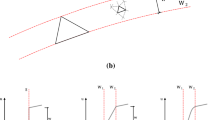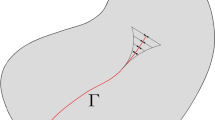Abstract
Tracking algorithms constitute an efficient numerical technique for modelling fracture in quasi-brittle materials. They succeed in representing localized cracks in the numerical model without mesh-induced directional bias. Currently available tracking algorithms have an important limitation: cracking originates either from the boundary of the discretized domain or from predefined “crack-root” elements and then propagates along one orientation. This paper aims to circumvent this drawback by proposing a novel tracking algorithm that can simulate cracking starting at any point of the mesh and propagating along one or two orientations. This enhancement allows the simulation of structural case-studies experiencing multiple cracking. The proposed approach is validated through the simulation of a benchmark example and an experimentally tested structural frame under in-plane loading. Mesh-bias independency of the numerical solution, computational cost and predicted collapse mechanisms with and without the tracking algorithm are discussed.




















Similar content being viewed by others
References
Ngo D, Scordelis C (1967) Finite element analysis of reinforced concrete beams. ACI J 64(3):152–163
Rashid Y (1968) Ultimate strength analysis of prestressed concrete pressure vessels. Nucl Eng Des 7:334–344
Mosler J, Meschke G (2004) Embedded crack versus smeared crack models: a comparison of elementwise discontinuous crack path approaches with emphasis on mesh bias. Comput Methods Appl Mech Eng 193(30–32):3351–3375
Peerlings RHJ, De Borst R, Brekelmans WAM, De Vree JHP (1996) Gradient enhanced damage for quasi-brittle materials. Int J Numer Methods Eng 39(19):3391–3403
Simone A, Wells GN, Sluys LJ (2003) From continuous to discontinuous failure in a gradient-enhanced continuum damage model. Comput Methods Appl Mech Eng 192:4581–4607
Bažant ZP, Lin FB (1988) Nonlocal smeared cracking model for concrete fracture. J Struct Eng 114:2493–2510
de Vree J, Brekelmans W, van Gils M (1995) Comparison of nonlocal approaches in continuum damage mechanics. Comput Struct 55:581–588
De Borst R (1991) Simulation of strain localization: a reppraisal of the cosserat continuum. Eng Comput 8:317–332
De Borst R, Sluys L, Mühlhaus H-B, Pamin J (1993) Fundamental issues in finite element analyses of localization of deformation. Eng Comput 10(2):99–121
Benedetti L, Cervera M, Chiumenti M (2015) Stress-accurate mixed FEM for soil failure under shallow foundations involving strain localization in plasticity. Comput Geotech 64:32–47
Jirásek M, Zimmermann T (2001) Embedded crack model. Part II. Combination with smeared cracks. Int J Numer Methods Eng 50(6):1291–1305
Wells GN, Sluys LJ (2001) A new method for modelling cohesive cracks using finite elements. Int J Numer Methods Eng 50(12):2667–2682
Moës N, Belytschko T (2002) Extended finite element method for cohesive crack growth. Eng Fract Mech 69:813–833
Dumstorff P, Meschke G (2007) Crack propagation criteria in the framework of X-FEM-based structural analyses. Int J Numer Anal Methods Geomech 31:239–259
Cervera M, Chiumenti M (2006) Mesh objective tensile cracking via a local continuum damage model and a crack tracking technique. Comput Methods Appl Mech Eng 196(1–3):304–320
Cervera M, Pelà L, Clemente R, Roca P (2010) A crack-tracking technique for localized damage in quasi-brittle materials. Eng Fract Mech 77(13):2431–2450
Slobbe A, Hendriks M, Rots J (2014) Smoothing the propagation of smeared cracks. Eng Fract Mech 132:147–168
Jirásek M, Grassl P (2008) Evaluation of directional mesh bias in concrete fracture simulations using continuum damage models. Eng Fract Mech 75(8):1921–1943
De Borst R (2001) Fracture in quasi-brittle materials: a review of continuum damage-based approaches. Eng Fract Mech 69:95–112
Rabczuk T (2012) Computational methods for fracture in brittle and quasi-brittle solids: state-of-the-art review and future perspectives. ISRN Appl Math 2013:1–61
Chen W-F (1982) Plasticity in reinforced concrete. McGraw-Hill, New York
Chen W-F (1994) Constitutive equations for engineering materials, vol 2 plasticity and modelling. Elsevier, Amsterdam
Feenstra PH, De Borst R (1996) A composite plasticity model for concrete. Int J Solids Struct 33:707–730
Mazars J, Pijaudier-Cabot G (1989) Continuum damage theory—application to concrete. J Eng Mech 115(2):345–365
Cervera M, Oliver J, Faria R (1995) Seismic evaluation of concrete dams via continuum damage models. Earthq Eng Struct Dyn 24(9):1225–1245
Lubliner J, Oliver J, Oller S, Oñate E (1989) A plastic-damage model for concrete. Int J Solids Struct 25(3):299–326
Lee G, Fenves GL (1998) Plastic-damage model for cyclic loading of concrete structures. J Eng Mech 124(8):892–900
Wu JY, Li J, Faria R (2006) An energy release rate-based plastic-damage model for concrete. Int J Solids Struct 43(3–4):583–612
Papa E (1996) A unilateral damage model for masonry based on a homogenisation procedure. Mech Cohes Frict Mater 1(February):349–366
Lourenço PB (2000) Anisotropic softening model for masonry plates and shells. J Struct Eng 126(9):1008–1016
Pelà L, Cervera M, Roca P (2013) An orthotropic damage model for the analysis of masonry structures. Constr Build Mater 41:957–967
Lopez J, Oller S, Oñate E, Lubliner J (1999) A homogeneous constitutive model for masonry. Int J Numer Methods Eng 46(10):1651–1671
Kouznetsova V, Geers MGD, Brekelmans WAM (2002) Multi-scale constitutive modelling of heterogeneous materials with a gradient-enhanced computational homogenization scheme. Int J Numer Methods Eng 54:1235–1260
Zucchini A, Louren PB (2002) A micro-mechanical model for the homogenisation of masonry. Int J Solids Struct 39:3233–3255
Lourenço PB, Milani G, Tralli A, Zucchini A (2007) Analysis of masonry structures: review of and recent trends in homogenization techniques. Can J Civ Eng 34(11):1443–1457
Calderini C, Lagomarsino S (2008) Continuum model for in-plane anisotropic inelastic behavior of masonry. J Struct Eng 134(2):209–220
Oliver J, Caicedo M, Roubin E, Huespe A, Hernández J (2015) Continuum approach to computational multiscale modeling of propagating fracture. Comput Methods Appl Mech Eng 294:384–427
Petracca M, Pelà L, Rossi R, Oller S, Camata G, Spacone E (2015) Regularization of first order computational homogenization for multiscale analysis of masonry structures. Comput Mech 57:257–276
Lourenço PB, Rots JG (1997) Multisurface interface model for analysis of masonry structures. J Eng Mech 123(7):660–668
Macorini L, Izzuddin BA (2011) A non-linear interface element for 3D mesoscale analysis of brick-masonry structures. Int J Numer Methods Eng 85:1584–1608
Oliveira S, Faria R (2006) Numerical simulation of collapse scenarios in reduced scale tests of arch dams. Eng Struct 28(10):1430–1439
Roca P, Cervera M, Gariup G, Pelà L (2010) Structural analysis of masonry historical constructions. Classical and advanced approaches. Arch Comput Methods Eng 17:299–325
Carvalho J, Ortega J, Lourenço PB, Ramos LF, Roman H (2014) Safety analysis of modern heritage masonry buildings: box-buildings in Recife, Brazil. Eng Struct 80:222–240
Mendes N, Lourenço PB (2014) Sensitivity analysis of the seismic performance of existing masonry buildings. Eng Struct 80:137–146
Jäger P, Steinmann P, Kuhl E (2008) On local tracking algorithms for the simulation of three-dimensional discontinuities. Comput Mech 42(3):395–406
Roth S-N, Léger P, Soulaïmani A (2015) A combined XFEM-damage mechanics approach for concrete crack propagation. Comput Methods Appl Mech Eng 283:923–955
Zhang Y, Lackner R, Zeiml M, Mang HA (2015) Strong discontinuity embedded approach with standard SOS formulation: element formulation, energy-based crack-tracking strategy, and validations. Comput Methods Appl Mech Eng 287:335–366
Saloustros S, Pelà L, Cervera M (2015) A crack-tracking technique for localized cohesive-frictional damage. Eng Fract Mech 150:96–114
Pelà L, Cervera M, Oller S, Chiumenti M (2014) A localized mapped damage model for orthotropic materials. Eng Fract Mech 124–125:196–216
Linder C, Raina A (2013) A strong discontinuity approach on multiple levels to model solids at failure. Comput Methods Appl Mech Eng 253:558–583
Motamedi MH, Weed DA, Foster CD (2016) Numerical simulation of mixed mode (I and II) fracture behavior of pre-cracked rock using the strong discontinuity approach. Int J Solids Struct 85–86:44–56
Li J-B, Fu X-A, Chen B-B, Wu C, Lin G (2016) Modeling crack propagation with the extended scaled boundary finite element method based on the level set method. Comput Struct 167:50–68
Wu JY, Li FB, Xu SL (2015) Extended embedded finite elements with continuous displacement jumps for the modeling of localized failure in solids. Comput Methods Appl Mech Eng 285:346–378
Feld-Payet S, Chiaruttini V, Besson J, Feyel F (2015) A new marching ridges algorithm for crack path tracking in regularized media. Int J Solids Struct 71:57–69
Comi C, Perego U (2001) Fracture energy based bi-dissipative damage model for concrete. Int J Solids Struct 38(36–37):6427–6454
Pelà L, Cervera M, Roca P (2011) Continuum damage model for orthotropic materials: application to masonry. Comput Methods Appl Mech Eng 200:917–930
Voyiadjis GZ, Taqieddin ZN, Kattan PI (2009) Theoretical formulation of a coupled elastic-plastic anisotropic damage model for concrete using the strain energy equivalence concept. Int J Damage Mech 18(7):603–638
Mazars J, Hamon F, Grange S (2014) A new 3D damage model for concrete under monotonic, cyclic and dynamic loadings. Mater Struct 48:3779–3793
He W, Wu YF, Xu Y, Fu TT (2015) A thermodynamically consistent nonlocal damage model for concrete materials with unilateral effects. Comput Methods Appl Mech Eng 297:371–391
Pereira LF, Weerheijm J, Sluys LJ (2016) A new rate-dependent stress-based nonlocal damage model to simulate dynamic tensile failure of quasi-brittle materials. Int J Impact Eng 94:83–95
Lemaitre J, Chaboche JL (1978) Aspect phenomenologique de la rupture par endommagement. J Mec Appl 2(3):317–365
Simo JC, Ju JW (1987) Strain- and stress-based continuum damage models-I. Formulation. Int J Solids Struct 23(7):821–840
Oliver J, Cervera M, Oller Martinez SH, Lubliner J (1990) Isotropic damage models and smeared crack analysis of concrete. In: Proceedings SCI-C computer aided analysis and design of concrete structures, Feb, pp 945–957
Bazant Z, Oh B (1983) Crack band theory for fracture of concrete. Mater Struct 16:155–177
Cervera M (2003) Viscoelasticity and rate-dependent continuum damage models, monography N-79, technical report, Barcelona
Oliver J (1989) A consistent characteristic length for smeared cracking models. Int J Numer Methods Eng 28(2):461–474
Wu J-Y, Cervera M (2015) On the equivalence between traction- and stress-based approaches for the modeling of localized failure in solids. J Mech Phys Solids 82:137–163
Cervera M, Wu J-Y (2015) On the conformity of strong, regularized, embedded and smeared discontinuity approaches for the modeling of localized failure in solids. Int J Solids Struct 71:19–38
ASTM:C496/C496M (2011) Standard test method for splitting tensile strength of cylindrical concrete specimens, vol 336. ASTM International, West Conshohocken, PA, pp 1–5
ASTM:D3967-08 (2008) Standard test method for splitting tensile strength of intact rock core specimens. ASTM International, West Conshohocken, PA
COMET (2013) Coupled mechanical and thermal analysis. http://www.cimne.com/comet/
GiD (2014) The personal pre and post-processor. http://www.gidhome.com/
EN (Eurocode 2) (1992) Design of concrete structures. Technical report, London
Augenti N, Parisi F, Prota A, Manfredi G (2011) In-plane lateral response of a full-scale masonry subassemblage with and without an inorganic matrix-grid strengthening system. J Compos Constr 15(4):578–590
Parisi F, Lignola GP, Augenti N, Prota A, Manfredi G (2011) Nonlinear behavior of a masonry subassemblage before and after strengthening with inorganic matrix-grid composites. J Compos Constr 15(5):821–832
EN 1998-1 (Eurocode 8) (2003) Design of structures for earthquake resistance, part 1 general rules seismic actions and rules for buildings
Fajfar P (1999) Capacity spectrum method based on inelastic demand spectra. Earthq Eng Struct Dyn 28:979–993
Acknowledgements
This research has received the financial support from the MINECO (Ministerio de Economia y Competitividad of the Spanish Government) and the ERDF (European Regional Development Fund) through the the MULTIMAS project (Multiscale techniques for the experimental and numerical analysis of the reliability of masonry structures, ref. num. BIA2015-63882-P) and the EACY project (Enhanced accuracy computational and experimental framework for strain localization and failure mechanisms, ref. MAT 2013-48624-C2-1-P). The authors gratefully acknowledge Dr. Fulvio Parisi for providing information regarding the experimental data.
Author information
Authors and Affiliations
Corresponding author
Rights and permissions
About this article
Cite this article
Saloustros, S., Pelà, L., Cervera, M. et al. Finite element modelling of internal and multiple localized cracks. Comput Mech 59, 299–316 (2017). https://doi.org/10.1007/s00466-016-1351-6
Received:
Accepted:
Published:
Issue Date:
DOI: https://doi.org/10.1007/s00466-016-1351-6




